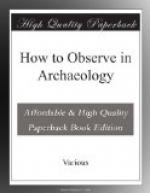Inscriptions occur on settlement-sites, in sanctuaries and associated with tombs: usually cut on slabs or blocks of soft limestone, though marble and other harder stones were used in Hellenistic and Roman times. Besides the ordinary Greek (see Illustration IV), and Roman alphabets the Phoenician alphabet (see Illustrations X and XI) was in use at Kition (Larnaca), in the great sanctuaries at Idalion (Dali), and occasionally elsewhere; and from early times until the fourth century a syllabary peculiar to Cyprus, often very rudely hewn, in irregular lines, on ill-shaped blocks. Such ‘Cypriote inscriptions’ (see accompanying Illustration VII) are of great value and interest, and have been often overlooked among building material drawn from old sites. In all doubtful cases, a ‘squeeze’ should be made by one of the methods described in the first part of this volume and submitted to the Keeper of Antiquities. The stamped inscriptions on the handles of wine-jars are worth preserving, as evidence for the course of trade.
Coins were issued in Cyprus from the sixth century onward; first in silver; later (in the fourth century B.C.) occasionally in gold, and from the fourth century commonly in copper. A Ptolemaic coinage succeeded in the third century that of the local rulers; the Roman coinage, with inscriptions sometimes in Greek, sometimes in Latin, lasts from Augustus to the beginning of the third century. Coins of the Byzantine Emperors and of the Lusignan Kings are common.
[Illustration VII: Bilingual (Greek and Cypriote) dedication to Demeter and Persephone from curium.]
CHAPTER V
Central and north Syria
[See the diagrams of flint implements, Illustration ii; of pottery and weapons, &c., VIII & IX; of alphabets, X & XI.]
The following notes are to be accepted as only a rough and imperfect guide, since no part of Syria, north of Palestine, has been widely or minutely explored, and the archaeology of the earliest period, in Central Syria, for example, is almost unknown.
The periods into which the archaeological history of Syria should be divided are roughly, as follows:
I. Neolithic and Chalcolithic
Age, to about 2000 B.C.
II. Bronze Age or Early Hittite,
to about 1100 B.C.
III. Iron Age or Late Hittite, to
about 550 B.C.
IV. Persian Period, to about
330 B.C.
V. Hellenistic Period, to
about 100 B.C.
VI. Roman Period.
VII. Byzantine Period.
I. Neolithic.
No purely Neolithic sites yet known, but lowest strata of remains at Sakjegozu and Sinjerli, on the Carchemish citadel, and in certain kilns at Yunus near by, and also pot-burials among house remains are of this Age. (But see Chapter VIII, Mesopotamia, whose Neolithic period is similar.)




